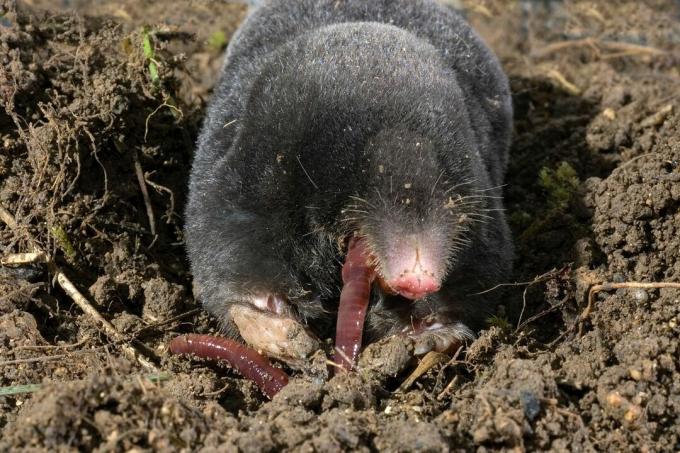The mole is extremely useful against many insect pests, if it weren't for the unloved mounds of earth. We give tips to drive the mole away.

Mole profile
The European mole (Talpa europae), like the hedgehog, is an insect eater. Direct damage to the roots of your cultivated plants by the mole can therefore be ruled out. The mammal, which is only 11-16 cm tall, is also protected under the Federal Species Protection Ordinance and may not be caught or killed. Previous control methods, such as a targeted division and drowning the animals with water, will hopefully be a thing of the past.
Incidentally, a mole feels most comfortable in humus-rich soil, as its favorite food (the earthworm) also finds the best living conditions there. The mole can eat a lot of them: up to 30 kg of insects per year are no problem for the mole! But since it also eats larvae of plant-damaging beetles and other animals at the same time, the presence of a mole is definitely not bad for the hobby gardener.

Where and when do you meet the mole most often?
In spring and summer, the insect eater also likes to live in open meadows and lawns. In winter, on the other hand, it prefers a protective layer of vegetation above the surface of the earth and therefore often retreats to the edges of forests and other overgrown areas. So if you have problems with piles of earth on the lawn during the gardening season, then the problem can also solve itself. The mole is extremely reluctant to overwinter in such places. In addition, it is a typical loner, so when it is not mating season, a coherent tunnel system is only inhabited by a mole. The tunnels are usually very close to the surface and only very rarely extend deeper than 50 cm into the ground. By the way, the mole is a real digging machine! In loose soil, opening 20 m of new tunnels a day is easy for him. So that the small animals do not suffocate in their tunnel system, they depend on air holes. For this reason, the molehills must not simply be trampled flat, as this is where the air exchange takes place.

Scare off the mole? But then please only use gentle methods!
Direct control is not allowed due to the nature conservation status mentioned above. If the molehills aren't too troublesome, then the mole will thank you if you leave them alone. The living area of the moles is not exactly increasing due to intensive agriculture. So you can decide for yourself whether you want to offer moles a retreat in your garden or not. If the digging work can no longer be endured, a few tricks can be used to ensure that the intelligent animal is looking for a new home. In doing so, you make use of the mole's sensitive olfactory and hearing senses. The use of so-called ultrasonic probes can help, but it can also cause trouble. Some models are quite audible and can quickly lead to a neighborly dispute. The effectiveness is also controversial to this day. That is why you should prefer to use fragrances. Our tip: Boil some water and let a few cloves of garlic steep. When the water has cooled it can in small ones Quantities to be given on the molehills. After all, the animal shouldn't be drowned. The application becomes more effective if it is done more often. There are also tried and tested vegetable oil-based products on the market. At this point we would like to point out again that driving away the mole without endangering its health is the only legal solution. Many sites promote the use of traps, but that too is forbidden! Firstly, the animals can be caught there, die after a short time and, secondly, they cannot be caught alive. Not only agriculture has a responsibility to the ecosystem and biodiversity. The hobby gardener can also contribute to positively influencing the ecosystem and biodiversity.

In addition to the mole, there are a few more Animals digging holes in the garden. We will introduce them to you and help you identify the holes in your garden.
